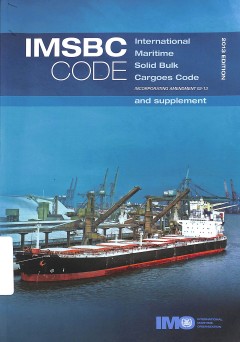Ditapis dengan

Presentations part time : Inland Waterways and Water transport
- Edisi
- Module Cargo Operation Management
- ISBN/ISSN
- -
- Deskripsi Fisik
- 23 page
- Judul Seri
- -
- No. Panggil
- CC STC PRE in C1
- Edisi
- Module Cargo Operation Management
- ISBN/ISSN
- -
- Deskripsi Fisik
- 23 page
- Judul Seri
- -
- No. Panggil
- CC STC PRE in C1

Syllabus : Module Cargo Operation Management
- Edisi
- Module Cargo Operation Management
- ISBN/ISSN
- -
- Deskripsi Fisik
- 128 page
- Judul Seri
- -
- No. Panggil
- CC STC SYL c C1
- Edisi
- Module Cargo Operation Management
- ISBN/ISSN
- -
- Deskripsi Fisik
- 128 page
- Judul Seri
- -
- No. Panggil
- CC STC SYL c C1

Cargo Operation Management : Dry Bulk Trading
- Edisi
- Module Cargo Operation Management
- ISBN/ISSN
- -
- Deskripsi Fisik
- 90 page
- Judul Seri
- Cargo Operation Management
- No. Panggil
- CC STC CAR d C1
- Edisi
- Module Cargo Operation Management
- ISBN/ISSN
- -
- Deskripsi Fisik
- 90 page
- Judul Seri
- Cargo Operation Management
- No. Panggil
- CC STC CAR d C1

Presentation material Part IV - Bulk Trading : Module Cargo Operation Management
- Edisi
- Module Cargo Operation Management
- ISBN/ISSN
- -
- Deskripsi Fisik
- 51 page
- Judul Seri
- -
- No. Panggil
- CC STC PRE C C1
- Edisi
- Module Cargo Operation Management
- ISBN/ISSN
- -
- Deskripsi Fisik
- 51 page
- Judul Seri
- -
- No. Panggil
- CC STC PRE C C1

IMSBC code : International maritime solid bulk cargoes code incorporating ame…
- Edisi
- 2013 Ed.
- ISBN/ISSN
- 978-92-801-1587-1
- Deskripsi Fisik
- v, 553 p., 32 cm
- Judul Seri
- -
- No. Panggil
- REF PO IMO i
- Edisi
- 2013 Ed.
- ISBN/ISSN
- 978-92-801-1587-1
- Deskripsi Fisik
- v, 553 p., 32 cm
- Judul Seri
- -
- No. Panggil
- REF PO IMO i

The Impact of Seafarers’ Perceptions of National Culture and Leadership on …
This research aims to examine the effects of national culture and leadership style on safety performance in bulk shipping companies. Survey data collected from 322 respondents working in dry bulk carriers was used, a multiple regression analysis was conducted to analyze the influence of national culture and leadership styles (i.e. transformational, passive management, and contingent reward) on …
- Edisi
- 4 (2016) 075 – 087
- ISBN/ISSN
- -
- Deskripsi Fisik
- 13 p.
- Judul Seri
- ScienceDirect
- No. Panggil
- ATC LO SHA t

Will the Northern Sea Route ever be a viable alternative?
Since the decline in sea ice north of Russia became clear in the early 1990s, ideas of using the northern route for sea transport between Europe and Asia have taken a hold of the shipping community. Large and small research projects with varying complexity and results have looked into this option. In this article, the available information is studied in detail and four scenarios for the costs a…
- Edisi
- 2016
- ISBN/ISSN
- 1464-5254
- Deskripsi Fisik
- 16 p.
- Judul Seri
- Maritime Policy & Management The flagship journal of international shipping and port research
- No. Panggil
- ATC LO PRU w

Dynamics of Dry Bulk Freight Market: Through the Lens of a Common Stochastic …
This paper shows the possibility that, as a simple average, BDI occasionally over- or under-states the status of global dry bulk freight market. In order to overcome this shortcoming, this paper suggests an alternative method of calculating new index by using a common stochastic trend model. This econometric approach to understanding the dynamics of dry bulk freight markets not only provides ne…
- Edisi
- Volume 27 Number 3 December 2011 pp. 387-404
- ISBN/ISSN
- -
- Deskripsi Fisik
- 18 p.
- Judul Seri
- The Asian Ournal of Shipping and Logistic
- No. Panggil
- ATC LO WOO d

An analysis of freight rate volatility in dry bulk shipping markets
The world bulk shipping market has been in a peak period since 2003, and this has lasted an incredibly long time considering that the markets are much more complex than before. This paper investigates the characteristics of volatility in dry bulk freight rates of different vessel sizes (capesize, panamax and handysize). The daily returns of freight rate indices of three different types of bulk …
- Edisi
- VOL. 35, NO. 3, 237–251
- ISBN/ISSN
- 1464–5254
- Deskripsi Fisik
- 17p
- Judul Seri
- Maritime Policy & Management: The flagship journal of international shipping and port research
- No. Panggil
- ATC LO JIN a

Evaluation of alternative logistics operations for the national supply of an …
One result of the continuing current competitive environment in Australia is cost pressure on the supply of manufacturing commodities such as anhydrous sodium sulphate. Commodity suppliers do not have much scope for providing value-added services. Anhydrous sodium sulphate, for example, is mostly brought to the customer’s attention when negative service characteristics occur – stocks run lo…
- Edisi
- Vol. 28 No. 5, 1998, pp. 382-395
- ISBN/ISSN
- 0960-0035
- Deskripsi Fisik
- 15 p
- Judul Seri
- International Journal of Physical Distribution & Logistics Management
- No. Panggil
- ATC LO GIL e

the Changing nature of the world bulk trades
- Edisi
- IJPD 6, 1
- ISBN/ISSN
- -
- Deskripsi Fisik
- 7 p.
- Judul Seri
- Communications Forum
- No. Panggil
- ACT MG KIN c
- Edisi
- IJPD 6, 1
- ISBN/ISSN
- -
- Deskripsi Fisik
- 7 p.
- Judul Seri
- Communications Forum
- No. Panggil
- ACT MG KIN c

Bulk commodity logistics
- Edisi
- 02 Mar 2017; 441-454
- ISBN/ISSN
- -
- Deskripsi Fisik
- 15 p.
- Judul Seri
- Handbook of Logistics and Supply-Chain Management
- No. Panggil
- ATC LO TRA b
- Edisi
- 02 Mar 2017; 441-454
- ISBN/ISSN
- -
- Deskripsi Fisik
- 15 p.
- Judul Seri
- Handbook of Logistics and Supply-Chain Management
- No. Panggil
- ATC LO TRA b

A simulation model for gate operations in multi-purpose cargo terminals
A multi-purpose cargo terminal in a seaport contains necessary infrastructure to handle different types of cargo, such as container, dry bulk, general bulk, and Ro-Ro. Since such terminals generally have dedicated areas and equipment for different types of cargo, berth, and yard operations for each type of cargo can be considered separate. On the other hand, trucks that carry all types of cargo…
- Edisi
- -
- ISBN/ISSN
- 1464-5254
- Deskripsi Fisik
- 15 p.
- Judul Seri
- The flagship journal of international shipping and port research
- No. Panggil
- ATC LO KEC a

A study on the charter cype choice of turkish general cargo and drybulk shipo…
The purpose of this study is to determine the most often preferred charter types by Turkish general cargo and dry bulk shipowners and investigate the criteria which affect and determine the selection of charter types. In the study, the methodology utilized constitutes literature review, in-depth interview and survey. The data gained through the survey was processed, through which the means wer…
- Edisi
- -
- ISBN/ISSN
- -
- Deskripsi Fisik
- 24 p.
- Judul Seri
- -
- No. Panggil
- ATC PO OZE a

Changing concentration ratios and geographical patterns of bulk ports: the ca…
Contrary to liner shipping, common shipping network patterns are difficult to organize in tramp shipping as origin and destination ports are irregular and they may change based on shippers’ demands. Unlike liner shipping whereas the choice of ports is strongly related to their geographical locations among other factors and a topic of much research in the contemporary literature, the geographi…
- Edisi
- Volume 30 number 2 August 2014
- ISBN/ISSN
- -
- Deskripsi Fisik
- 19 p.
- Judul Seri
- The asian journal of shipping and logistic
- No. Panggil
- ATC PO LEE c

Stacker-reclaimer scheduling in a dry bulk terminal
A dry bulk terminal acts as a multi-modal interface for transhipping iron ores. Stacker reclaimers are the dedicated equipments in storage yard for iron ore handling. Both unloading and loading processes are supported by stackerreclaimers in most cases. The operation efficiency of dry terminals heavily depends on the productivity of stackerreclaimers. This paper discusses the stacker-reclaimer …
- Edisi
- vol. 25
- ISBN/ISSN
- 1362-3052
- Deskripsi Fisik
- 13 p.
- Judul Seri
- International Journal of Computer Integrated Manufacturing
- No. Panggil
- ATC PO DAY s

Changing concentration ratios and geographical patterns of bulk ports : the c…
Contrary to liner shipping, common shipping network patterns are difficult to organize in tramp shipping as origin and destination ports are irregular and they may change based on shippers’ demands. Unlike liner shipping whereas the choice of ports is strongly related to their geographical locations among other factors and a topic of much research in the contemporary literature, the geographi…
- Edisi
- Volume 30 Number 2 August 2014
- ISBN/ISSN
- -
- Deskripsi Fisik
- 19 p.
- Judul Seri
- -
- No. Panggil
- ATC PO LEE c

Operational risk management in maritime transport : tools, trends, methodolog…
- Edisi
- Volume 27 Number 3
- ISBN/ISSN
- -
- Deskripsi Fisik
- 6 p.
- Judul Seri
- -
- No. Panggil
- ATC MR THA o
- Edisi
- Volume 27 Number 3
- ISBN/ISSN
- -
- Deskripsi Fisik
- 6 p.
- Judul Seri
- -
- No. Panggil
- ATC MR THA o

Containerization of bulk trades: A case study of US–Asia wood pulp transport
Containerization of bulk cargo has gradually emerged in recent decades, particularly along the US–East Asia trade route (China, Japan and South Korea). One of the background factors in the emergence of this phenomenon is an imbalance between eastbound and westbound container cargo movements along this route. Nonetheless, the factors that affect containerization have not yet been identified. W…
- Edisi
- Vol. 17, 2, 179–197
- ISBN/ISSN
- -
- Deskripsi Fisik
- 19 p.
- Judul Seri
- Maritime Economics & Logistics
- No. Panggil
- ATC LO MAT c

The development of generic training material for portworkers in the dry bulk …
Since the late 1980s the ILO has supported the implementation of effective portworker training through the provision of generic training materials under its Portworker Development Programme (PDP). The programme is to be extended to include the major dry bulk trades, initially focusing on iron ore, coal and phosphate rock. In 2010 a study was conducted to gain an understanding of the organisatio…
- Edisi
- vol.27
- ISBN/ISSN
- -
- Deskripsi Fisik
- 30 pages
- Judul Seri
- the asian journal of shipping and logistic
- No. Panggil
- ATC PO MAR t

Refrigerated container versus bulk: evidence from the banana cold chain
During the last 20 years, the reefer shipping sector has been characterised by a gradual changing process, leading from specialised vessels to reefer containers. In fact, the reefer bulk fleet has experienced an irreversible decline, while the reefer container fleet has shown a continuous growth. This article investigates the current major factors shaping the reefer shipping industry, in order …
- Edisi
- Vol. 42, No. 3, 228–245
- ISBN/ISSN
- -
- Deskripsi Fisik
- 19 p.
- Judul Seri
- Maritime Policy & Management
- No. Panggil
- ATC LO PAR r

Seaborne trade between developed and developing countries
This paper analyses the international grain trade flow by using the gravity equation of trade. On the basis of microeconomic theory and the new trade theory, the gravity equation of trade is used to examine grain exports and imports between pairs of countries. One of the main purposes of this paper is to examine how the grain trade is affected by economic factors, population, and country develo…
- Edisi
- -
- ISBN/ISSN
- -
- Deskripsi Fisik
- 22 p.
- Judul Seri
- The Korean Association of Shipping and Logistics
- No. Panggil
- ATC LO LEU s
 Karya Umum
Karya Umum  Filsafat
Filsafat  Agama
Agama  Ilmu-ilmu Sosial
Ilmu-ilmu Sosial  Bahasa
Bahasa  Ilmu-ilmu Murni
Ilmu-ilmu Murni  Ilmu-ilmu Terapan
Ilmu-ilmu Terapan  Kesenian, Hiburan, dan Olahraga
Kesenian, Hiburan, dan Olahraga  Kesusastraan
Kesusastraan  Geografi dan Sejarah
Geografi dan Sejarah